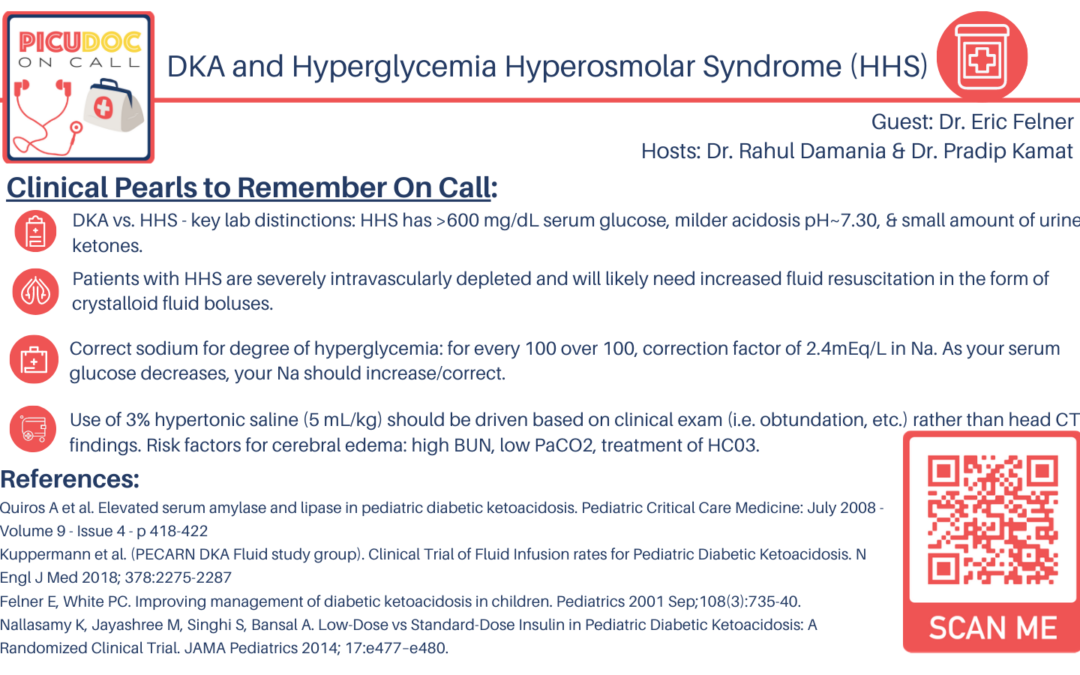Today’s episode is dedicated to the differentiation and management of diabetic ketoacidosis (DKA) and hyperosmolar hyperglycemic state (HHS)
We are delighted to be joined by Dr. Eric Felner. Dr. Felner is a Professor of Pediatrics/Pediatric Endocrinology at the Emory University School of Medicine and is an Adjunct Professor of Chemical and Biomedical Engineering at Georgia Tech.
Show Highlights:
- Our case, symptoms, and diagnosis: A 15-year-old male presents with a one-week history of increased urination. He is otherwise healthy except for a viral URI last week. He is found to be disoriented and tachycardic, with an exam notable for delayed peripheral capillary refill and cool extremities. The patient has deep, labored respirations upon examination, and labs confirm hyperglycemia with a serum glucose of 850, mild acidosis, and 2+ ketones. His CPK level is elevated, and a crystalloid fluid bolus is started.
- Hyperosmolar hyperglycemic state is defined as a serum glucose greater than 600 mg/dL, serum osmolality of 330 mOsm/kg, and the absence of ketosis and acidosis.
- The key difference between HHS and DKA is that DKA is characterized by the presence of ketones in the blood and acidosis, but HHS means these are completely absent.
- Even though DKA and HHS are similar, their management strategies have their own nuances.
- In DKA, the lack of insulin leads to management strategies, while HHS is marked by complete dehydration and excessive urination.
- Factors that point to HHS will be a very overweight child, family history, and ethnicity; Type-2 diabetes is much more common in African-American, Latin-American, and Native-American children, while Type-1 is more common in Caucasians.
- Specific labs for patients with suspected DKA or HHS include a comprehensive metabolic panel (CMP), blood gas, and CPK for HHS.
- For both conditions, management strategies focus on insulin and fluid administration, but there are key differentiations:
- DKA is managed using the triple bag therapy that was pioneered by Dr. Felner.
- There is a risk for cerebral edema with administering fluid.
- The most important data relating to fluid administration with regard to neurological outcomes is what we have learned in calculating fluids with the “2x maintenance formula” to guard against mistakes that could result in cerebral edema.
- Key considerations regarding low-dose vs. standard-dose insulin therapy revolve around the weight and age of the pediatric patient.
- For HHS, the key is to manage fluids and give insulin; for Type-1 diabetics, the key is to eliminate acidosis.
- Key PICU management pearls in minimizing cerebral edema risks are to determine the level of sickness by the PCO2 level, high BUN, and by not giving bicarbonate. Remember that children under age 5 have a higher risk for cerebral edema.
- In the management of both DKA and HHS, remember that it comes down to how sick a patient is and not necessarily following the numbers.
- In general pediatrics, managing a sick DKA patient means giving an IV, administer fluids, and call a specialist management team right away.
- Dr. Felner discusses the association between COVID-19 and Type 1 diabetes based on his experience.
- As intensivists and endocrinology teams work together to transition patients to an intermittent insulin regimen, it’s important to remember how to convert from IV insulin to subQ insulin.
- Takeaway clinical pearls include the key diagnostic elements between DKA and HHS. In HHS, patients will have higher glucose levels, milder acidosis, mild ketosis, and increased dehydration. Both conditions will have insulin and fluid management, and HHS patients may require increased fluid resuscitation.

